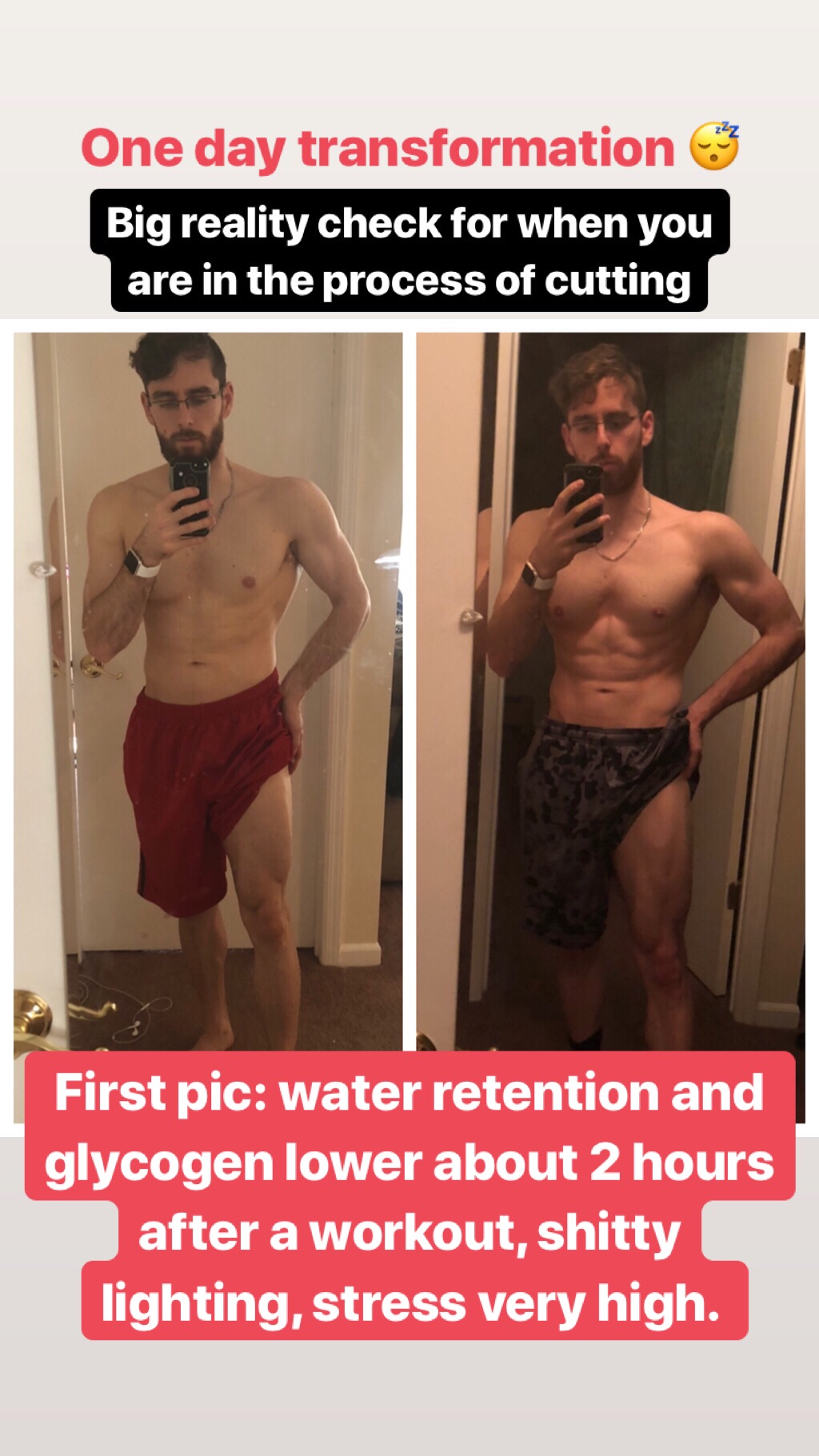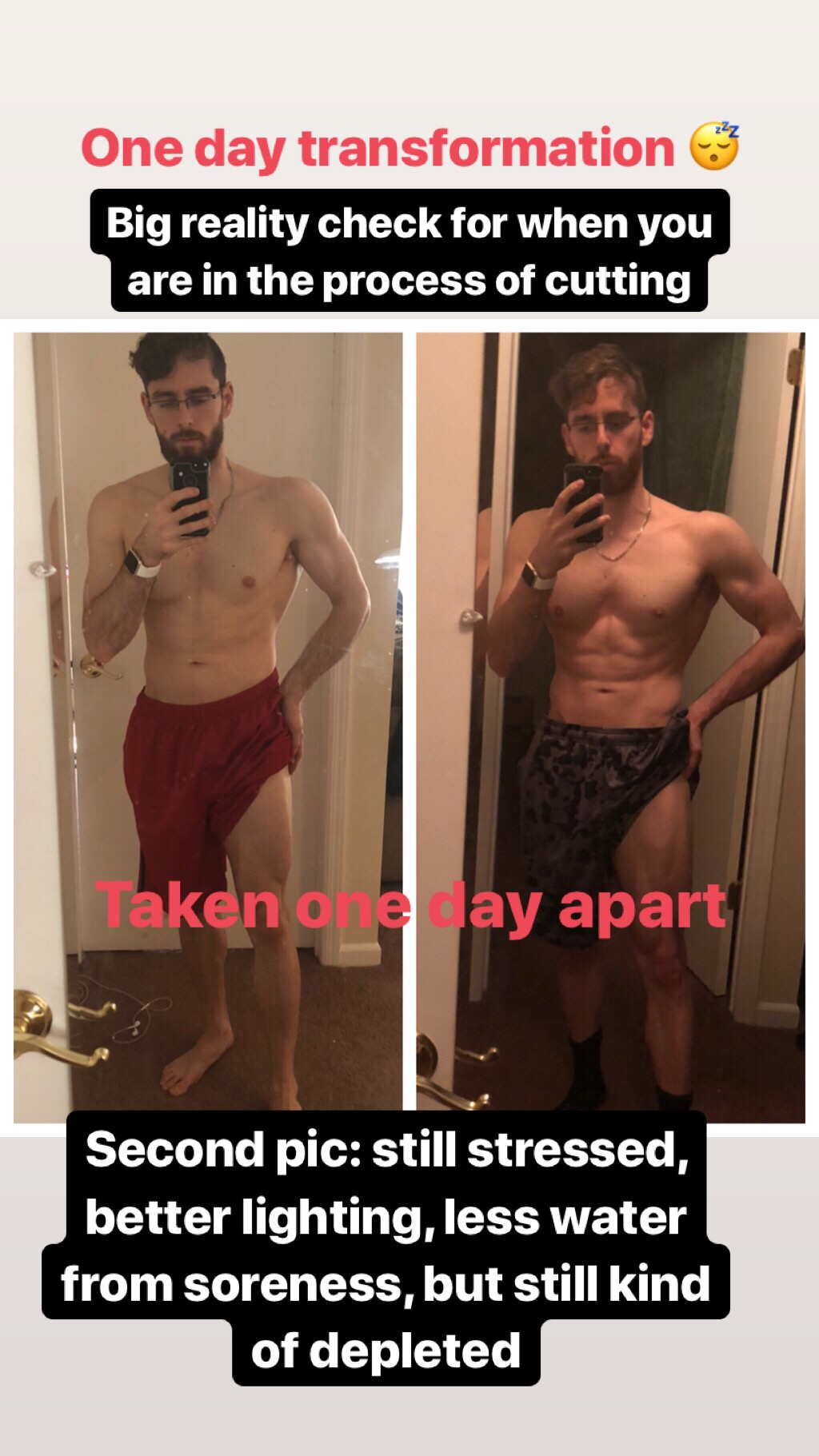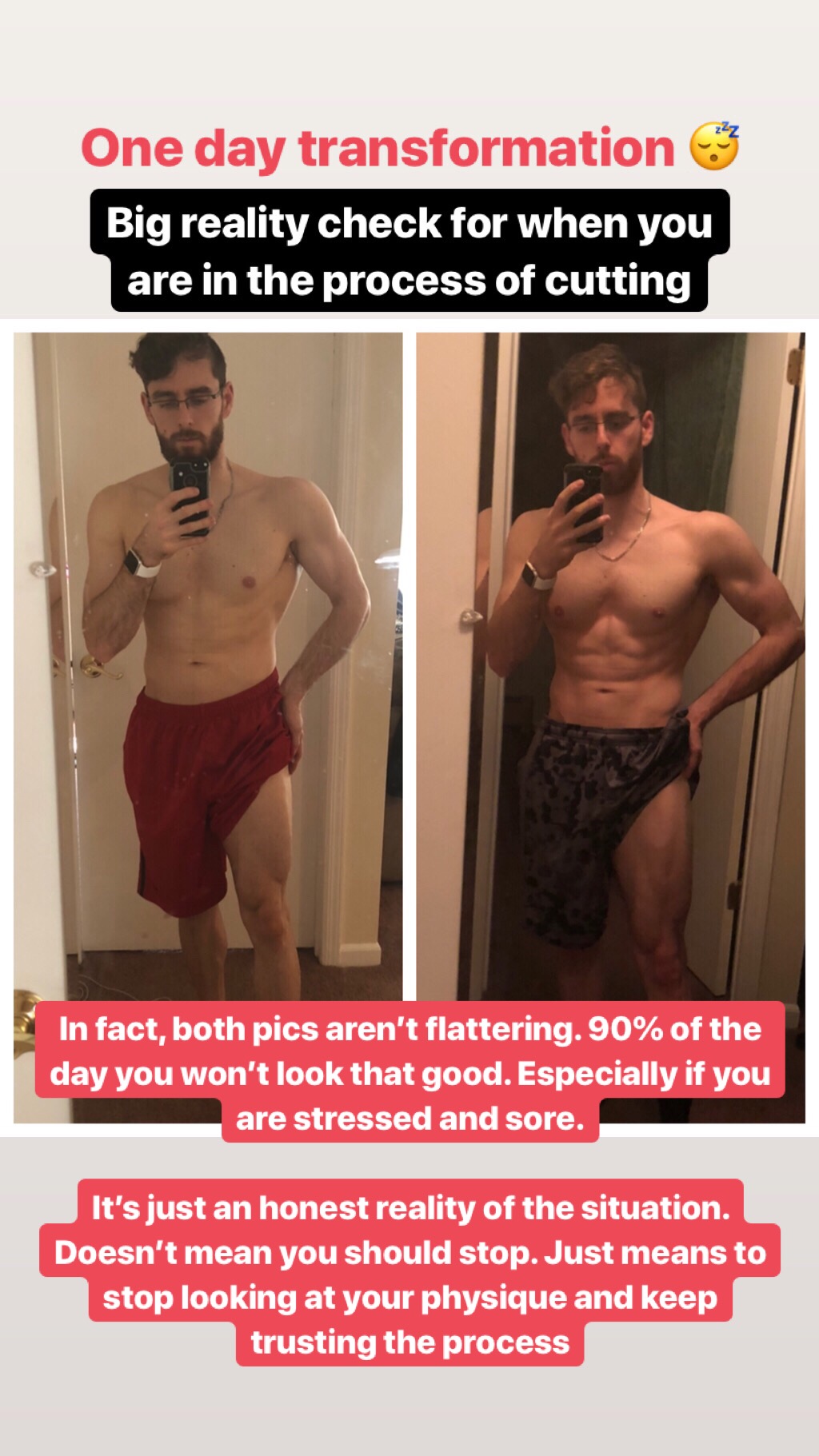Brandon's Contest Prep: Week 3
This is the third official entry for my “Contest Prep Diary” for 2019. Click Below to read week 2:
RECAP
Week 3 started off really well! I hit some big numbers in training and was getting some great pumps (which aren’t as common while dieting). But after my first leg session on Monday, I felt a WAVE of diet fatigue suddenly hit me.
Was I surprised this happened?
Not really, it had been 17 days in a deficit before I had my first real sign that things were starting to get real. So I was expecting it. I was even pretty sure WHY it happened as well. Training was inevitably getting harder and I had some serious hamstring soreness from good mornings and DB RDLs after that monday leg day.
Week 2 and Week 3 Scale Weight Data
understanding high weigh-ins
Part of this paints the picture of my scale weight this week compared to last week.
Messed with my Head: I’ll be honest, I did not take these scale weight readings as well as I should have. They definitely messed with my head a little bit. BUT I understood why they were what they were.
Harder to TTP: While last week, I made a point to “trust the process”, this week I needed more evidence and justification behind why scale weight did not drop and even went UP on a couple of days.
Leg Soreness: Again, it pays off to have a coach and a good amount of data working together. The reason for the high weigh-ins is primarily due to my leg soreness and edema that came from that hamstring dominant leg session.
Remember, the hamstrings, and legs in general are the biggest muscles on your body. You’ll often find that especially when doing hip hinges, that those movements can create a LOT of delayed onset muscle soreness.
In the days preceding, your legs will be sore and they will look and feel “puffier” as I like to call it. The body is stressed and holding onto water in those areas. When you weigh yourself in the morning it is imperative that you take notes relating to the overall stress that you can point to within your body on that day.
ON the days I weighed 174-175, my legs were VERY Sore. They were even a little tight going into my leg session later in the week, where my glutes were then subsequently sore in the preceding days. I did not have this kind of soreness in week 2. Luckily, I was still able to progress with my training, hit my macros every day, and do daily walks to hit my step count (more on that later).
nutrition
Even while writing this, the edema and soreness STILL hasn’t fully gone away and it is masking some of my weight loss AND overall appearance. Which ties into what I wanted to talk about next
CUTTING YOU DON’T LOOK YOUR BEST
When you are cutting in a calorie deficit, you will NOT look your best. While you are losing fat, the look you are holding during the process is not as good as what it will look like at the END. Some points to remember:
Glycogen storages: When in a calorie deficit, your glycogen storages in your muscles will be more depleted than usual. Having filled glycogen storages makes for good pumps and giving you a “fuller” look.
Your muscles will be rounder, bigger and have more definition when fully loaded with glycogen. BUT if your muscles are always full of glycogen, which is a storage form of energy, then you won’t be needing to use as much fat storage for energy use.
Stress accumulation: As I touched on earlier, the rise in stress levels is going to cause your body to hold onto water. Even if you did not work out a particular body part, your body can hold water all over. Top this onto the fact that you are glycogen depleted and you will have an even fluffier look to yourself.
Filling foods: Eating high volume, nutrient dense foods are going to make the calorie deficit more manageable, but they are also going to make your stomach distended. This is good when dieting to control hunger, but not the best if you are trying to see how defined your midsection is.
Negative Mood: When dieting for a period of time, you have less energy to devote towards keeping your mood in check. The stress and biological “cravings” to eat are going to make most people moody and impatient when dieting. This in itself often leads to a lot of dieters, myself included, who can overthink things when in the process of dieting.
One part about that is thinking you look a lot worse than you actually do. You attach a certain stigma towards your look and then the shitty mood from the day on top of it compounds what is actually there.
My Caffeine Consumption
Less is More? Right now, I am actually trying to average even LESS caffeine than I did in my previous cutting phases.
Reason being is that for ME, I am generally pretty sensitive to caffeine. I never drank coffee or energy drinks in college to help me study. I only started taking pre-workout half way through college. Like a lot of people I know, I got hooked on a particular brand that had a lot of stimulants on it.
I got slightly addicted to the feeling of being so alert and productive that I would CRASH HARD later in the day. It wasn’t sustainable long term to have vicious mood swings that were a result of caffeine/pre workout consumption.
Caffeine Sweet Spot: Over a 2-3 year period I ended up finding a sweet spot of caffeine intake throughout the day where I can get in my training, be productive at work and not go through crazy mood swings because of the peak alertness and come down later on.
Diet before this Diet: The cutting cycle right before my diet break, I was probably average around 200 or so mg a day. I would take more caffeine before my leg sessions (twice a week) and then sometimes I even needed some green tea at work as a pick me up in the later weeks when I was really tired.
For me, the hardest part of dieting are the mood swings and doubting thoughts that come up when on low energy. Therefore, during this cutting phase I wanted to make sure I really only used my Minimum Effective Dosage of Caffeine so that when things get harder, I am still sensitive enough to caffeine that I will get all of it's benefits.
Control the HYPE: I also am doing this because when I am hyped off a lot of caffeine I will want to just train SUPER HARD in the gym. As I will touch on later, this is a big accumulator of fatigue and you should only do this type of training sparingly. Therefore, I did not want to have an external output that was purposely making it easier to mistake the plethora of energy for a cue to go all in with my training.
I would rather save those higher caffeine sessions for my week 4 training, where I am pushing everything close to failure.
Current approach through week 3:
140 mg (as a monster) pre workout, 5 days a week
2 rest days, no caffeine consumption, 2 days a week
Working out in the AM, so no caffeine at least 10+ hours before bed
Training
Energy reserves get more and more scarce when dieting. Additionally, stress becomes more and more plentiful.
Energy Budget: Therefore, you have to be tight with your energy “budget” as I like to call it.
Training is a very peculiar entity within the cutting process, because it's something you more or less NEED to keep in.
Stresses from outside areas such as work, school, social life, events, relationship problems, or general anxiety can be apparent or completely non-existent depending on the person.
Necessary Stress: But the ONE stress that all of us dieters will go through is managing training stress.
As you get deeper and deeper into a diet, you have to shift your thought process to be a bit more “physique” orientated as opposed to concentrating on “strength” in the pure tonnage you put on the bar each week.
As a bodybuilder, no one is going to ask me what I bench, squat or deadlift when I’m posing on stage. They just want to see how muscular and shredded I am.
managing fatigue in your training
Therefore, within your training you need to assess tradeoffs that are going to provide a great “stimulus to fatigue” ratio.
In this training block, I wanted to touch on a couple of ways I am managing fatigue through my exercise selection:
Flawless Form: The easiest way to ensure quality stimulus is with impeccable form. No wasted movement. No assistance from body parts not being worked in getting the weight up. A deadlift where you yank on the bar, round your upper back and cut your range of motion is not going to have quality stimulus for your glutes. But man, is that going to contribute a lot of unnecessary fatigue.
Chest-Supported Rows: On one of the two days I hit my back musculature, I included a seated row variant. This allows me to take stress of my glutes, hamstrings, and spinal erectors that normally get taxed a tad during a strict bent-over row variation. Doing rows seated allows me to focus more on the execution of the lift and make sure more quality volume is concentrated onto the back as opposed to other muscles being the limiting factor.
Cable Curls: At times, machine work can be more effective for a stimulus-fatigue ratio. Because the apparatus is fixed in a plane of direction, it requires less mental energy to concentrate on locking your body in and you can thus concentrate more on mind muscle connection and execution. In this instance, I have put in higher rep cable curls over my usual barbell curls.
Pause Squats: When doing paused squats, a couple things happen. First is, you will not be using the stretch reflex that normally happens with the eccentric portion of the lift. This makes the lift harder and secondly, you will have to use less weight. By using less weight on your back, you not only make the lift safer, but you get less peripheral fatigue from having to hold the bar on your back and it compressing your spine and tiring your erectors/traps.
Adding reps > load: While strength has a large correlation to muscle size, it's not the only avenue we have to progressing in our training. By adding load onto the bar, you have to focus more on the load simply not coming down and crushing you. That focus gets higher and higher as the weight gets closer and closer to your one rep max. Therefore, for practicality sake and to avoid potential injury, it makes sense to not ALWAYS add load in order to progress and sometimes just strive to get more total reps more a particular movement.
mindset
Day to Day Process:
A Big theme of this contest prep diet, as well as my life in general is to be “process orientated”. It's very easy to get distracted by the big picture of what you want to achieve, especially in bodybuilding. If not careful, you can lost in constantly comparing:
Your Strength to others
Your Physique within mere days from the last assessment
Someone else’s Peak Physique to your current state
Diet or Training strategies that others are using
The HIGHS of all the other fitness people you follow on social media
All of these situations can negatively effect your OWN process. You’ll constantly ask yourself:
“Why don’t I have that?” or “Why don’t I look like that yet?”
It will create a vicious cycle of overthinking that will put stress at the forefront of all the great progress you are ACTUALLY making. Furthermore, in some instances you will NEVER achieve some of the things that others have.
There are physiques, that given the person’s genetics, situation and opportunity will be something I will never look like. Therefore, to get the most satisfaction out of what I AM doing, I must focus on MY process.
Check Boxes
One simple way I do this is by having “checkboxes” that I can nail every day that are under my control:
Macros/Steps: Every single day of the cut, I must do the best of my abilities to make sure that I am within the prescribed macro range (my macros are in week 1) and hit at least 8000 steps (tracked on my apple watch) every day.
I can’t control the pace of my fat loss, but I can control my intake for the most part and NOT miss track macros or eat foods that put me over. While in a more relaxed dieting phase, that’s okay from time to time. But every little thing can matter in these coming months.
Sleep: This is one of the main reasons I wanted to get this check box log. If I make a conscious effort to have a bedtime and a routine around it, then I was sure that I could get at least 8-9 hours of sleep every night. So far, through 3 weeks, I am right there.
Posing: This will even be more important later on in the process. A complete package on stage also requires that you know how to show it off. Posing is an underrated aspect when competing in bodybuilding and is something you can’t casually pick up the week before.
Training: I LOVE training and therefore, I never skip it. But within the training, it's more than just showing up. It's ticking the variables within my training as well. Did I come in with the right mindset? Did I hit the weeks given proximity to failure? Did I make smart progression jumps and use great technique?
Sharing: I also make it a point to share part of my journey each day. It's as simple as “what is something that happened to me today that's worth putting out there?”. All those little stories over time have manifested into these blog entries as well.
conclusion
The tail end of week 3 was starting to get a little rough. With Diet Fatigue setting in, it was important for me to keep a level head coming into a Big Week 4.
Next week, I will talk more about:
Training Mindset on Hard Weeks
How to deal with Super Low Energy Levels in a Diet
Thanks for Reading!
Any further questions, ask me on Instagram: @brandonjod













